H/T from an article at www. RailsWest.com:
Please visit their website for a lot of good information!
Railway Post Office Cars Sort & Distribute Mail
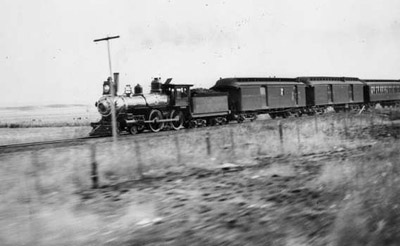
Railway Post Office Cars were used to pick up, sort and distribute first class mail, magazines, newspapers and registered mail between cities on the vast majority of passenger trains in the United States. RPO routes formed a network crisscrossing the United States.
The first recorded use of the railroads to carry the mail was on a route from Philadelphia to Lancaster, Pennsylvania, beginning in December 1832. Stage coach contractors Samuel Slaymaker and Jesse Tomlinson were granted an allowance of $400 per year "for carrying the mail on the railroad as far as West Chester" (30 miles). Similar contracts were granted in some other areas.
The Post Office appointed a Route Agent, John Kendall, to accompany the mails between Albany and Utica, New York, in 1837. In 1838 and 1840, agents were assigned to attend the mail between Washington, D.C., and Philadelphia and between Boston and Springfield, Massachusetts.
The United States Congress officially designated all railroads as official postal routes on July 7, 1838. The act increased the use of railroads to transmit the mails and limited the use of post riders and horse-drawn vehicles to post offices that were not on railway routes. Mail service by railroad increased rapidly.
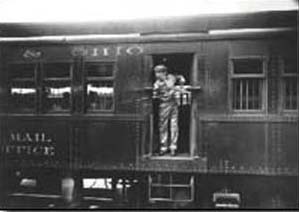 Initially, mail was sorted only at the distributing post offices. Eventually the postal
agents began opening the bags they picked up along the route and distributing
the mail to the bags that were being dropped off further down the line.
The first purpose built RPO cars entered service on the Hannibal
and St. Joseph Railroad in 1862, at the direction of
Postmaster General Montgomery Blair. Overland mail from the
east had been backing up in St. Joseph. To expedite delivery,
William A. Davis, postmaster
of St. Joseph, used the car to separate mail for connection with
a westbound stage departing soon after the train's arrival
at St. Joseph, Missouri.
Initially, mail was sorted only at the distributing post offices. Eventually the postal
agents began opening the bags they picked up along the route and distributing
the mail to the bags that were being dropped off further down the line.
The first purpose built RPO cars entered service on the Hannibal
and St. Joseph Railroad in 1862, at the direction of
Postmaster General Montgomery Blair. Overland mail from the
east had been backing up in St. Joseph. To expedite delivery,
William A. Davis, postmaster
of St. Joseph, used the car to separate mail for connection with
a westbound stage departing soon after the train's arrival
at St. Joseph, Missouri.An increasing volume of mail during the Civil War led to the beginning of a national railway mail system in 1864. The first permanent Railway Post Office route was officially established in August when George B. Armstrong, the assistant postmaster of Chicago, Illinois, placed a postal car equipped for general distribution in service between Chicago and Clinton, Iowa, on the Chicago & Northwestern Railroad. This service is differed from the 1862 operation because mail was sorted to and received from each post office along the route, as well as major post offices beyond the route's end-points. Similar routes were established between New York and Washington; Chicago and Rock Island, Illinois; Chicago and Burlington, Illinois; and New York and Erie, Pennsylvania.
Railway Mail Service Inaugurated
In 1869, the Railway Mail Service was officially inaugurated, headed by George
B. Armstrong, to handle the transportation and sorting of mail aboard trains. Use of full service RPO cars became
widespread, by the 1880s, railway post office routes were operating on the vast majority of passenger
trains in the United States.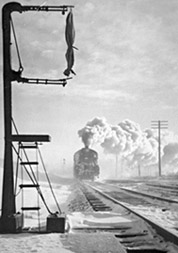 Passenger
trains didn't stop at every station along the route. To pick up
the mail pouch from a smaller town non-stop station, a Ward
mail-bag catcher, which used a steel catcher arm affixed to the
door of railway post office cars, was used by clerks to extend
the catcher arm as the train approached a non-stop station along
the route and pick up mail from a fixed crane on the fly.
The patent for the device was awarded to L.F. Ward of Elyria,
Ohio, in January 1867, they began use in 1969. The mail pouch
for that station would be tossed out where the station agent or a
postal worker would promptly retrieve it.
Passenger
trains didn't stop at every station along the route. To pick up
the mail pouch from a smaller town non-stop station, a Ward
mail-bag catcher, which used a steel catcher arm affixed to the
door of railway post office cars, was used by clerks to extend
the catcher arm as the train approached a non-stop station along
the route and pick up mail from a fixed crane on the fly.
The patent for the device was awarded to L.F. Ward of Elyria,
Ohio, in January 1867, they began use in 1969. The mail pouch
for that station would be tossed out where the station agent or a
postal worker would promptly retrieve it.A fast and exclusive mail train was introduced in September 1875, consisting of five cars, designed to expedite the movement of mail from the east to the west between New York and Chicago. Traveling on the New York Central and the Pennsylvania railroads, the first train carried more than 33 tons of mail in about 24 hours.
Railway Mail Clerks were subjected to stringent training and ongoing testing of details regarding their handling of the mail. On a given RPO route, each clerk was expected to know not only the post offices and rail junctions along the route, but also specific local delivery details within each of the larger cities served by the route. On busier routes several railway mail clerks would work as a team in each car.
The Postmaster General's 1896 annual report for the Railway Mail Service indicates that the mails were carried on 172,794 miles of railroad, and 6,779 postal clerks were employed on 152,825 miles of traveling post offices that included railroads, steamboats, and electric cars. Casualty figures for the years 1877 to 1896 showed that 94 clerks were killed in the line of duty, and 821 were seriously injured on the job through derailments, falls, drownings, fires, other work-related accidents and train robberies.
Railway Postal Car Standards Established
In 1912 the Post Office Department's established standards for
the construction
of railway postal cars. Three basic car or compartment lengths
were agreed upon, 15-foot and 30-foot compartments, and full
length 60-foot cars; with standard features including letter
cases, pouch and paper racks, and overhead boxes.
The pouch and paper racks were in five foot sections; each section could
be folded up against the side of the car when not in
use. Standardization made cars interchangeable so they
might be used on any trip assignment. All 60-foot RPO cars built
after 1912 were of all-steel construction.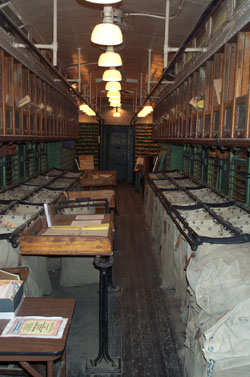 The inside of RPO cars included letter cases for sorting first class mail,
pouch and paper racks for sorting magazines and newspapers, and storage
space at each end. Mail was sorted for distribution to cities along
the route, was cancelled when necessary, and dispatched to post offices
in towns along the route. Registered mail was also handled, and the foreman
in charge was required to carry a regulation pistol while on duty to discourage
theft of the mail.
The inside of RPO cars included letter cases for sorting first class mail,
pouch and paper racks for sorting magazines and newspapers, and storage
space at each end. Mail was sorted for distribution to cities along
the route, was cancelled when necessary, and dispatched to post offices
in towns along the route. Registered mail was also handled, and the foreman
in charge was required to carry a regulation pistol while on duty to discourage
theft of the mail.On most railroads RPO cars had a mail slot on the side of the car, so that mail could actually be deposited in the car, much like using the corner mail box, while the train was stopped at a station. The mail handled in this manner received a cancellation just as if it had been mailed at a local post office, with the cancel giving the train number, endpoint cities of the RPO route and the date, and offered the fastest delivery as overnight delivery would be virtually assured.
Fast Mail and Express Trains speed Mail between Cities
While
the majority of RPO service consisted of one or more cars at
the head
end of passenger trains, many railroads operated solid mail
trains between
major cities; these solid mail trains would often carry 300
tons of mail
daily. The fast mail train would have precedence over all
other scheduled trains on the line. The first transcontinental
Fast Mail to the Pacific ran in 1889; from Chicago, this
involved the Chicago & Council Bluffs RPO on the Burlington
Railroad, Omaha & Ogden
RPO on the Union
Pacific Railroad, and the Ogden & San Francisco RPO on the Central Pacific Railroad.
In later years, the Chicago & Omaha
RPO on the Chicago & North Western Railroad gradually took over the link between Chicago and Omaha. The Atchison, Topeka & Santa Fe began fast mail service between Los Angeles and Kansas City, Missouri, in November 1897.1 Eventually the service became trains Nos. 7 and 8, the Fast Mail and Express between Los Angeles and Chicago. These trains were assigned a 60-foot Railway Post Office car, such as RPO Car No. 60, and typically four mail storage cars. Additional cars would be added when needed. For a number of years passenger cars would be added to the end of the train, typically a coach-baggage combine and a coach, or just the coach-baggage combine.
For the 10 to 11 Railway Mail Clerks assigned to ATSF Fast Mail and Express Train No. 8, the day would begin in Los Angeles between 8:30 a.m. and an 11:30 departure time. Mail would arrive in separated in pouches and sacks for the various cars on the train. Two storage cars were loaded with sacks and pouches going beyond Winslow, Arizona, the other two storage cars were used for taking on and putting off mail at stations along the line. A pair of Santa Fe employees rode the storage cars, and took in additional sacks and pouches, which were filled by the Railway Mail Clerks as the train rolled along. Sacks and pouches taken in would be sorted by the Railway Mail Clerks, three clerks were typically assigned to first class mail, one handled newspapers, one handled registered mail and one handled mixed mail. Additional clerks were assigned for mail going to specific states, typically California and Arizona, Colorado and New Mexico, Texas, Oklahoma, and Illinois.2
From the time they started work in Los Angeles to their arrival in Ash Fork, Arizona, after midnight the following morning, the Railway Mail Clerks worked through the night to keep up with the flow of mail being received and distributed. A second crew would replace them at Ash Fork, as the train continued toward Chicago. The Railway Mail Clerks worked in a 28 day cycle, working six days, followed by eight days off, with at least 3 round trips in each month.
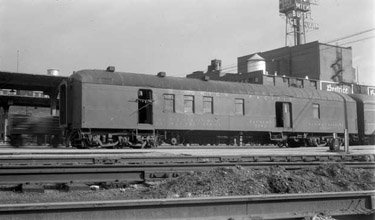 In 1930, more than 10,000 trains were used to move the mail into every city, town, and village
in the United States. Shortly after W.W.II, there were 1500 RPO routes crisscrossing the United
States with 30,000 workers in more than 4,000 cars.
In 1930, more than 10,000 trains were used to move the mail into every city, town, and village
in the United States. Shortly after W.W.II, there were 1500 RPO routes crisscrossing the United
States with 30,000 workers in more than 4,000 cars.
Mail Sorting and Distribution shifts away from RPO Cars
The decline in passenger travel during the 1930's and 1940's led the railroads to reduce the number of trains, which also
affected the number of RPO routes.
In February 1941, the first Highway Post Office began service between Washington & Harrisonburg, Va. in
a large bus that was equipped somewhat like a RPO car.
In 1949, the Post Office Department renamed the Railway Mail Service to the
Postal Transportation Service, or PTS. In
1951 there were 700 RPO routes in service, less than half the number of routes than at the end of W.W.II. More
than 130 HPO routes were established by 1955.In 1963, the Sectional Center concept of transit mail service was announced, along with ZIP coding of mail. With this new system the first three digits of the ZIP code describe the central mail processing Sectional Center Facility, or SCF. The SCF sorts mail to all post offices with those first 3 digits in their ZIP codes. Mail is then sorted according to the final 2 digits of the ZIP code and the sorted mail is sent to these post offices in the early morning. As centralized processing of mail was implemented, there was little need for the RPO Cars and HPO busses. Long distance truck transportation was replacing RPO routes and first-class mail began to be transported in airplanes. By 1965, only 190 trains carried mail.
By 1970, the railroads carried virtually no First-Class Mail. In 1971, the Post Office Department terminated seven of the eight remaining routes. The only remaining railway post office ran between New York and Washington, D.C., the highest populated corridor in the nation, which made its last run on June 30, 1977.
For additional reading:
- Bruns, James H. Mail on the Move. Polo, Illinois: Transportation Trails, 1993.
- Romanski, Fred J. The "Fast Mail": A History of the U.S. Railway Mail Service, Prolog Magazine, Fall 2005, Vol. 37, No. 3, College Park, MD.
- White, John H. Jr. The American Railroad Passenger Car. 1978, Johns Hopkins University Press, Baltimore MD. 2 vols.
- Wilking, Clarence. The Railway Mail Service, Railway Mail Service Library, Boyce, Virginia, 1985.
2 Romanski, Fred J. Prolog Magazine, The "Fast Mail": A History of the U.S. Railway Mail Service, Fall 2005, Vol. 37, No. 3
RPO and Fast Mail Passenger Cars at Orange Empire Railway Museum
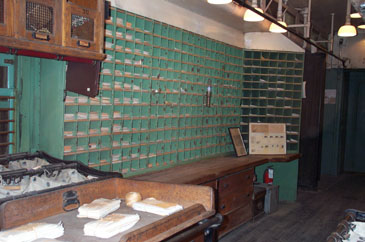 ATSF
Railway Post Office Car No. 60 was used to sort and distribute mail
between Los Angeles and Kansas City, on trains Nos. 7 and 8, the Fast Mail and Express. At Kansas City Car No.
60 was replaced by an identical car for the run to Chicago. The Post Office Department terminated the route
in 1967. Built: 1924, by Pullman Car & Manufacturing Company, Construction:
Steel, Length: 64 feet 3 inches. RPO Car No. 60 has been restored with cases
and bags set up as if the car were in service.
ATSF
Railway Post Office Car No. 60 was used to sort and distribute mail
between Los Angeles and Kansas City, on trains Nos. 7 and 8, the Fast Mail and Express. At Kansas City Car No.
60 was replaced by an identical car for the run to Chicago. The Post Office Department terminated the route
in 1967. Built: 1924, by Pullman Car & Manufacturing Company, Construction:
Steel, Length: 64 feet 3 inches. RPO Car No. 60 has been restored with cases
and bags set up as if the car were in service. ATSF Baggage Mail Combination Car No. 2055 was built for the Atchison, Topeka & Santa Fe. Divided into two compartments, the "heavyweight" car is of the "thirty footer" type as it contained 30 feet of postal distribution space, used to sort and distribute mail on routes where a full length RPO car was not needed. Baggage was carried in the compartment at the other end of the car. Car No. 2055 was part of the last order of cars of this type built for the ATSF. All were built to Post Office requirements. Built: 1930, by Pullman Car & Manufacturing Company, Construction: Steel, Length: 73 feet 1 inch. The car was reportedly used on the Los Angeles to San Diego trains, it is also reported to have been used on the Atchison, Topeka & Santa Fe "Fast Mail and Express" trains, No. 7 and No. 8.
ATSF Coach Baggage Combination Car No 2602 accommodated a limited number of passengers, the train crew and baggage, on the Atchison, Topeka & Santa Fe "Fast Mail and Express" trains, No. 7 and No. 8. Built: 1923, by the Pullman Company, Rebuilt: 1938, Construction: Steel, Length: 83 feet 11 inches.
Union Pacific Railway Post Office Car No. 2065. In 1907 the Union Pacific and Southern Pacific introduced their first steel RPO cars under the leadership of Edward H. Harriman, President and principal owner of both lines. Car No. 2065 was built to revised "Harriman" common standards and to Post Office Requirements. Originally numbered 1267, it was renumbered No. 2065 in February 1916. It is a standard "sixty footer" type as it contains 60 feet of distribution space. Built 1914, by the Pullman Company, Construction: Steel, 63 feet 7 inches.
Pacific Electric Baggage Mail Combination Car No. 1406. The PE operated two RPO routes, the West route and the South route. During the 1930's three trips were made on each route daily, except Sundays. Three cars were assigned. A third route to San Bernardino was added in 1947, it made one trip daily except Sunday. Mail arriving in Los Angeles for delivery in areas served by the PE RPO routes was separated by Railway Mail Clerks on the main line railroads. Long distance mail was also sorted on the cars and prepared for transfer to the ATSF, SP and UP. The last RPO run was in 1950 on the San Bernardino route. Manufactured by Brill, 1913, originally for the Portland, Eugene & Eastern, acquired by the PE in 1928. Construction: Steel, 52 feet 3/4 inch, retired 1959.
No comments:
Post a Comment